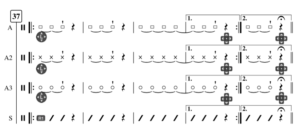by Granzow and Park
PS Quartet No. 2 – for electronic ensemble
PS Quartet No.2 is here! Five of EMEWS members recorded a version (Alex MacColl-Artrip, Sean Monaghan, Jacob Joslin, Ebony Swain, Gavin Langley), but four or more people can perform the piece. The only hardware needed besides the computer (either Mac or PC) is a Playstation DualShock controller. The interested ensemble can perform it with Logitech game controllers (F310 or similar on both Mac and PC) or XBox controller (Mac only). The piece runs on SuperCollider, a multi-platform audio software.
The links below contain score and SuperCollider patches. Feel free to contact me if you have any questions.
2023 Update – Participants at Nief-Norf Summer Festival presented PS Quartet No.2 during the 2022 Summer Festival! Here’s the video.
An Interview With Kill Screen
I did a fun interview with Kill Screen magazine. Read about my recent projects and aesthetics.
2019 EMEWS Tour Set
Download the linked .zip file containing SuperCollider files and scores for
- PS Quartet No. 1
- PS Quartet No. 2
- phonetinus_
- Singaporean Crosswalk
- Seven Bird Watchers
Seven Bird Watchers – for electronic ensemble
Seven Bird Watchers (2019) for a drum machine ensemble. For a performance, three or more drum machine players change parameters of the machine according to the score. The pulse of the drum machines is synced to a customized sync track that fluctuates seven times between slow and fast. Three percussive instruments make bird-like chirping when they are on speedy tempo.
The score is available at the following link.
https://joowonpark.net/wordpress/wp-content/uploads/2019/06/SevenBirdWatchers.pdf
The sync signals are downloadable in the following link in three formats: mp3, SuperCollider file (.scd), and mp4 (video).
Seven Bird Watchers Performance Data
Here’s a tutorial video on how to interpret the score

